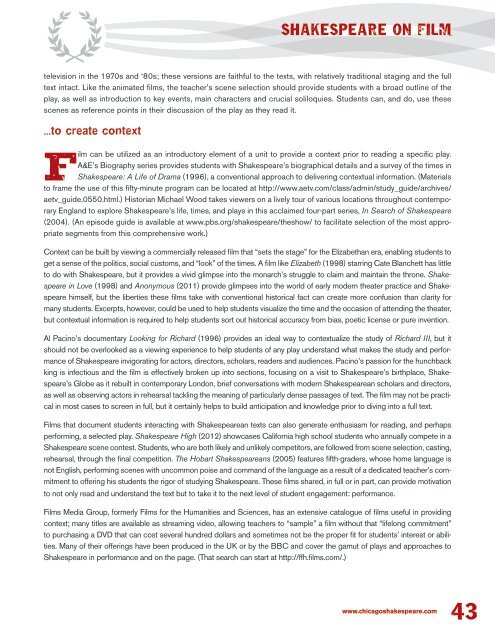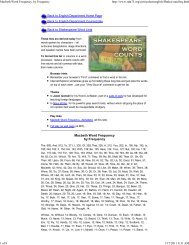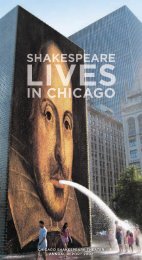Julius Caesar • 2013 - Chicago Shakespeare Theater
Julius Caesar • 2013 - Chicago Shakespeare Theater
Julius Caesar • 2013 - Chicago Shakespeare Theater
You also want an ePaper? Increase the reach of your titles
YUMPU automatically turns print PDFs into web optimized ePapers that Google loves.
television in the 1970s and ‘80s; these versions are faithful to the texts, with relatively traditional staging and the full<br />
text intact. Like the animated films, the teacher’s scene selection should provide students with a broad outline of the<br />
play, as well as introduction to key events, main characters and crucial soliloquies. Students can, and do, use these<br />
scenes as reference points in their discussion of the play as they read it.<br />
…to create context<br />
SHAKESPEARE ON FILM<br />
Film can be utilized as an introductory element of a unit to provide a context prior to reading a specific play.<br />
A&E’s Biography series provides students with <strong>Shakespeare</strong>’s biographical details and a survey of the times in<br />
<strong>Shakespeare</strong>: A Life of Drama (1996), a conventional approach to delivering contextual information. (Materials<br />
to frame the use of this fifty-minute program can be located at http://www.aetv.com/class/admin/study_guide/archives/<br />
aetv_guide.0550.html.) Historian Michael Wood takes viewers on a lively tour of various locations throughout contemporary<br />
England to explore <strong>Shakespeare</strong>’s life, times, and plays in this acclaimed four-part series, In Search of <strong>Shakespeare</strong><br />
(2004). (An episode guide is available at www.pbs.org/shakespeare/theshow/ to facilitate selection of the most appropriate<br />
segments from this comprehensive work.)<br />
Context can be built by viewing a commercially released film that “sets the stage” for the Elizabethan era, enabling students to<br />
get a sense of the politics, social customs, and “look” of the times. A film like Elizabeth (1998) starring Cate Blanchett has little<br />
to do with <strong>Shakespeare</strong>, but it provides a vivid glimpse into the monarch’s struggle to claim and maintain the throne. <strong>Shakespeare</strong><br />
in Love (1998) and Anonymous (2011) provide glimpses into the world of early modern theater practice and <strong>Shakespeare</strong><br />
himself, but the liberties these films take with conventional historical fact can create more confusion than clarity for<br />
many students. Excerpts, however, could be used to help students visualize the time and the occasion of attending the theater,<br />
but contextual information is required to help students sort out historical accuracy from bias, poetic license or pure invention.<br />
Al Pacino’s documentary Looking for Richard (1996) provides an ideal way to contextualize the study of Richard III, but it<br />
should not be overlooked as a viewing experience to help students of any play understand what makes the study and performance<br />
of <strong>Shakespeare</strong> invigorating for actors, directors, scholars, readers and audiences. Pacino’s passion for the hunchback<br />
king is infectious and the film is effectively broken up into sections, focusing on a visit to <strong>Shakespeare</strong>’s birthplace, <strong>Shakespeare</strong>’s<br />
Globe as it rebuilt in contemporary London, brief conversations with modern <strong>Shakespeare</strong>an scholars and directors,<br />
as well as observing actors in rehearsal tackling the meaning of particularly dense passages of text. The film may not be practical<br />
in most cases to screen in full, but it certainly helps to build anticipation and knowledge prior to diving into a full text.<br />
Films that document students interacting with <strong>Shakespeare</strong>an texts can also generate enthusiasm for reading, and perhaps<br />
performing, a selected play. <strong>Shakespeare</strong> High (2012) showcases California high school students who annually compete in a<br />
<strong>Shakespeare</strong> scene contest. Students, who are both likely and unlikely competitors, are followed from scene selection, casting,<br />
rehearsal, through the final competition. The Hobart <strong>Shakespeare</strong>ans (2005) features fifth-graders, whose home language is<br />
not English, performing scenes with uncommon poise and command of the language as a result of a dedicated teacher’s commitment<br />
to offering his students the rigor of studying <strong>Shakespeare</strong>. These films shared, in full or in part, can provide motivation<br />
to not only read and understand the text but to take it to the next level of student engagement: performance.<br />
Films Media Group, formerly Films for the Humanities and Sciences, has an extensive catalogue of films useful in providing<br />
context; many titles are available as streaming video, allowing teachers to “sample” a film without that “lifelong commitment”<br />
to purchasing a DVD that can cost several hundred dollars and sometimes not be the proper fit for students’ interest or abilities.<br />
Many of their offerings have been produced in the UK or by the BBC and cover the gamut of plays and approaches to<br />
<strong>Shakespeare</strong> in performance and on the page. (That search can start at http://ffh.films.com/.)<br />
www chicagoshakespeare com 43




